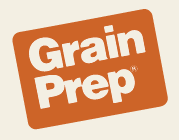Grain Prep® Processing Aid
Grain conditioning presents two challenges.

- The outer seed coat must be penetrated rapidly.
- The surface tension of water must be reduced to allow for maximum "wetting" action.
Water alone will eventually penetrate the seed coat in 24 to 72 hours, depending on temperature. Grain Prep Processing Aid greatly increases the rate of moisture penetration, allowing grain to be stored and handled dry until immediately before final processing. This is a distinct advantage since very few feed mills are equipped to handle wet grain and grain that is suitably moist for feed manufacturing will not stay in condition long.
In theory there are other ways to condition grain. A strong organic acid such as propionic or a mineral acid such as nitric, sulfuric or phosphoric can reduce a seed coat’s ability to slow water penetration. However, this would require a large volume of concentrated acid and prolonged high temperature. The amount of acid typically applied as part of a grain tempering product is several orders of magnitude less than would be required affect the seed coat. Even preservative levels of propionic acid that are applied to stored grain are several orders of magnitude larger than the amount typically applied with a grain tempering product. The amount of acid required to affect the seed coat would be highly corrosive to feed mill equipment.
While materials such as lecithin and lignin sulfonate reduce the surface tension of water and are considered to be wetting agents, they are oils that tend to form a coating that can actually inhibit the penetration of water into the grain. The acidity in most grain tempering products functions solely to emulsify the other ingredients, which are neither water soluble nor dispersible. In order to be dispersed in water they must first be dissolved in an acid, such as propionic. The acid is a necessary part of the formulation of these products that has nothing to do with penetration of the seed coat.
The second function of a grain conditioner is as a wetting agent, causing water to form a film rather than droplets. This increases the contact between the water and the "wetted" surface. If there is good penetration of the seed coat, like that provided by Grain Prep Processing Aid, the increased contact will significantly enhance the rate of moisture absorption by the grain being processed.
Grain Prep Processing Aid Formulation
Grain Prep Processing Aid includes no acids in the formulation. Instead it is formulated with sarsaponin, a powerful, natural wetting and emulsifying agent. This naturally occurring compound functions in nature to rapidly transfer moisture into plant tissue and retain it. This natural action addresses both absorption and dispersion problems and allows Grain Prep Processing Aid to add as much as fifteen percent moisture to whole kernel grain in as little as 30 minutes. No other product can come close to adding as much moisture as quickly as Grain Prep Processing Aid.
After moisture gets through the seed coating, starch very rapidly absorbs moisture and firmly bonds the water to itself. Any material in a grain conditioner that forms a film will only hinder this process. Grain Prep Processing Aid is the only grain conditioner or wetting agent on the market formulated specifically to penetrate the seed coat, to rapidly "wet" the grain, and to retain moisture after the grain has been processed for feed.
The Grain Prep Processing Aid formulation is 100% active ingredient, significantly reducing the volume of material needing to be purchased, shipped, or inventoried. The concentrated formula simplifies inventory control, and the use rate for Grain Prep Processing Aid is just 6.4 grams per ton (U.S.) of grain treated per point of moisture added.
Grain Prep Processing Aid offers some very significant advantages:
- It is formulated to provide optimum wetting, optimum emulsifying action, and superior moisture retention.
- It works with a wide variety of feed grains including wheat, corn, barley, oats, sorghum and soy beans.
- It includes no acids.
- All ingredients in the formulation are “generally recognized as safe” for both human and animal uses, so there are no safety restrictions, nor is an MSDS required.
- It has a freezing point below -30°F.
- The use cost is just 8.3 cents per ton (U.S.) of grain treated per percent moisture added.
Technical Data
| Sarsaponin content | 8.0% minimum |
|---|---|
| pH | 6.6 |
| Solubility | Completely soluble in water |
| Yucca schidigera extract, propylene glycol, sucrose, potable water |
|---|
| Specific gravity | 1.26 |
|---|---|
| Bulk density | 10.5 pounds per gallon (U.S.) |
| Viscosity (60°F) | 184 centipoise |
| Color | Dark brown |
| Freezing point | Below -30°F |
| Note: Grain Prep Processing Aid is irritating to mucous membranes. Flush contacted surfaces with clean cool water. It also readily forms a very stable foam. Avoid surface agitation when mixing or diluting. | |
| Toxicity | None, to warm blooded animals |
|---|---|
| Flammability | None, aqueous liquid |
